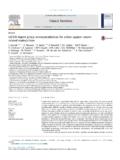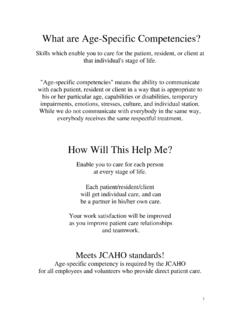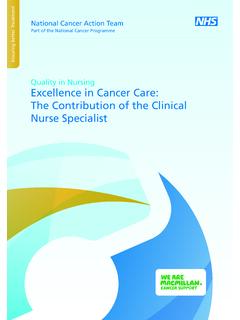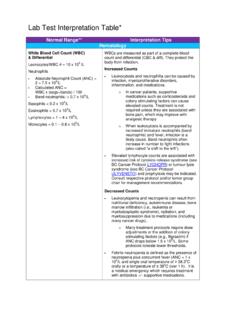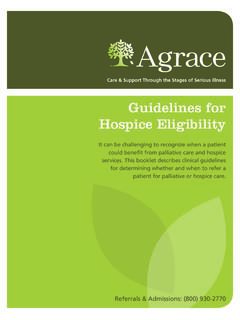Transcription of Hospice Admission Guidelines
1 Are eligible for Hospice care when their physician determines the patient has a life expectancy of six (6) months or less. The determinants within this guide are to be used as Guidelines and should not take the place of a physician s clinical curative treatment is no longer available, Hospice can be a beneficial care option for patients and a tremendous source of emotional and physical support for their families. Hospice care includes a full range of services, including medical, pharmaceutical, social and spiritual questions regarding patient eligibility Guidelines call the Provider Hotline at HospiceHow to Make a ReferralWebsite:Fax:Email: referral form is secure and HIPAA faxing referral, include patient Hospice Alexander Cohen Hospice HouseThe Community Hospice Alexander Cohen Hospice House provides 16 private inpatient rooms and 24-hour care in a comfortable home-like setting. Admission to the Hospice House is based on physician approval, acuity/need and available space.
2 The Community Hospice Alexander Cohen Hospice House is essentially a Hospice hospital and it is intended for short term respite care and symptom management. Once symptoms are managed the patient either returns home or moves to an alternate care facility, and Community Hospice will continue to provide services in the patient s new become a patient at the Community Hospice Alexander Cohen Hospice House, individuals must be a Community Hospice patient. Routine Patient receives Hospice care at the place he/she care Patient received Hospice care consisting predominantly of licensed nursing care on a continuous basis at home. Continuous home care is only furnished during brief periods of crisis and only as necessary to maintain the terminally ill patient at Inpatient (GIP) Patient received general inpatient care in an inpatient facility for pain control or acute or complex symptom management which cannot be managed in other Patient receives care in an approved facility on a short-term basis in order to provide respite for the Levels of CareAlzheimer s DiseaseAmyotrophic Lateral Sclerosis (ALS)CancerCerebral Vascular Accident/Stroke or ComaHeart Disease/CHFHIV DiseaseHuntington s DiseaseLiver DiseaseLung Disease/COPDM ultiple SclerosisMuscular DystrophyMyasthenia Gravis Parkinson s DiseaseRenal Failure ChronicAPPENDIX 1-NYHA Functional ClassificationsAPPENDIX 2 Palliative Performance ScaleAPPENDIX 3-Functional Assessment StagingIMPORTANT NOTEST able of ContentsAlzheimer s DiseaseThe patient has both 1 and 2:1.
3 Stage VII or beyond according to the Functional Assessment Staging Scale* with all of the2. Following: *See Appendix 3 for Functional Assessment Staging Scale Inability to ambulate without assistance Inability to dress without assistance Urinary and fecal incontinence, intermittent or constant No consistent meaningful/reality-based verbal communication; stereotypical phrases or the ability to speak is limited to a few intelligible words ANDHas had at least one (1) of the following conditions within the past twelve (12) months: Aspiration pneumoniaAlzheimer s Disease Pyelonephritis or other upper urinary tract infection Septicemia Decubitus ulcers, Multiple and/or Stage 3-4 Fever, recurrent after antibiotics Inability to maintain sufficient fluid and caloric _intake demonstrated by either of the following; a. 10% weight loss during the previous (6) monthsOR b.
4 Serum albumin < the absence of one or more of these findings, rapid decline or comorbidities may also support eligibility for Hospice Lateral Sclerosis (ALS)The patient meets at least one of the following (1 or 2):1. Severely impaired breathing capacity with all of the following findings: Dyspnea at rest Vital capacity less than 30% Requirement for supplemental oxygen at rest The patient declines artificial ventilationOR2. Rapid disease progression with either a or b below: Rapid disease progression as evidenced by all of the following in the preceding twelve (12) months; Progression from independent ambulation to wheelchair or bed-bound status Progression from normal to barely intelligible or unintelligible speech Progression from normal to pureed diet Progression from independence in most or all Activities of Daily Living (ADLs) to needing major assistance by caretaker in all ADLsAmyotrophic Lateral Sclerosis (ALS)a.
5 Severe nutritional impairment demonstrated by all of the following in the preceding twelve(12) months; Oral intake of nutrients and fluids insufficient to sustain life Continuing weight loss Dehydration or hypovolemia Absence of artificial feeding methodsORb. Life-threatening complications demonstrated by one or more of the following in the preceding twelve (12) months; Recurrent aspiration pneumonia (with or without tube feeding) Upper urinary tract infection (Pyelonephritis) Sepsis Recurrent fever after antibiotic therapy Stage 3 or Stage 4 decubitus ulcers(s)In the absence of one or more of the above findings, rapid decline or comorbidities may also support eligibility for Hospice patient has 1, 2, and 3:1. Clinical findings of malignancy with widespread, aggressive, or progressive disease as evidenced by increasing symptoms, worsening lab values and/or evidence of metastatic disease2.
6 Impaired performance status with a Palliative Performance Score *(PPS) <70%. *See Appendix 2 for Palliative Performance Scale3. Refuses further curative therapy or continue to decline despite definitive therapy. Decline is evidenced by: Hypercalcemia>12 Cachexia or weight loss of 5% in the preceding three months Recurrent disease after surgery/radiation/chemotherapyCancer Refusal to pursue additional curative or prolonging cancer treatment Signs and symptoms of advanced disease ( , nausea, anemia, malignant ascites or pleural effusion, etc.)The following information will be required;1. Tissue diagnosis of malignancyOR2. Reason(s) why a tissue diagnosis is not availableIn the absence of one or more of the above findings, rapid decline or comorbidities may also support eligibility for Hospice Vascular Accident/Stroke or ComaThe patient has both 1 and 2:1. Poor functional status with Palliative Performance Scale* of 40% or less (unable to care self) *See Appendix 2 for Palliative Performance ScaleAND2.
7 Poor nutritional status with inability to maintain sufficient fluid and calorie intake with either; >10% weight loss over the previous six (6) months > weight loss over the previous three (3) months Serum albumin < history of pulmonary aspiration without effective response to speech language pathology interventions to improve dysphagia and decrease aspiration eventsCerebral Vascular Accident/Stroke or ComaSupporting evidence for Hospice eligibility:Coma (any etiology) with three (3) of the following on the third (3) day of coma; Abnormal brain stem response Absent verbal responses Absent withdrawal response to pain Serum creatinine> the absence of one or more of these findings, rapid decline or comorbidities may also support eligibility for Hospice Disease/CHFThe patient has 1 or 2 and 3:1. Poor response to (or patient s choice is not to pursue) optimal treatment with diuretics, vasodilators, and/or angiotensin converting enzyme (ACE) inhibitorsOR2.
8 The patient has angina pectoris at rest resistant to standard nitrate therapy and is not a candidate for invasive procedures and/or has declined revascularization procedures AND3. New York Heart Association (NYHA)*Class IV symptoms with both of the following: *See Appendix 1 for New York Heart Association (NYHA) Functional Classification Heart Disease/CHF The presence of significant symptoms of recurrent Congestive Heart Failure (CHF) and/or angina at rest Inability to carry out even minimal physical activity without symptoms of heart failure (dyspnea and/or angina)Supporting evidence for Hospice eligibility: Echo demonstrating and ejection fraction of 20% or less Treatment resistant symptomatic dysrhythmias History of unexplained or cardiac related syncope CVA secondary to cardiac embolism History of cardiac arrest or resuscitationIn the absence of one or more of these findings, rapid decline or comorbidities may also support eligibility for Hospice DiseaseThe patient must have 1a or b, 2 and 3:1a.
9 CD4+ Count <25 cells/mm3OR1b . l Persistent viral load >100,000 copies/ml from two (2) or more assays at least one (1) month apartAND2. At least one (1) of the following conditions: CNS lymphoma Untreated or refractory wasting (loss of >33% lean body mass) Mycobacterium avium complex ( MAC) bacteremia, untreated, refractory or treatment refused Progressive multifocal leukoencephalopathy Systemic lymphoma Refractory visceral Kaposi s sarcoma Renal failure in the absence of dialysis Refractory cryptosporidium infection Refractory toxoplasmosis Treatment resistant symptomatic dysrhythmias History of unexpected or cardiac related syncope CVA secondary to cardiac embolism History of cardiac arrest or resuscitationAND3. Palliative Performance Scale* of 5o% (requires considerable assistance and frequent medical care , activity limited mostly to bed or chair) *See Appendix 2 for Palliative Performance evidence for Hospice eligibility: Chronic persistent diarrhea for one year Persistent serum albumin < Concomitant active substance abuseIn the absence of one or more of these finding, rapid decline and comorbidities may also support eligibility for Hospice DiseaseHuntington s DiseaseThe patient has both 1 and 2:1.
10 Stage VII or beyond according to the Functional Assessment Staging Scale* with all of the following: *See Appendix 3 for Functional Assessment Staging Inability to ambulate without assistance In ability to dress without assistance Urinary and fecal incontinence, intermittent or constant No consistent meaningful verbal communicationAND2. Has had at least one (1) of the following conditions within the past twelve (12) months: Aspiration pneumonia Pyelonephritis or other upper urinary tract infection Septicemia Decubitus Ulcers, Multiple, Stage 3 4 Toxoplasmosis unresponsive to therapy Fever, recurrent after antibiotics Inability to maintain sufficient fluid and caloric intake with one of more of the following during the preceding twelve (12) months: a. 10% weight loss during the previous six (6) monthsOR b. Serum albumin < c. Significant dysphagia with associated aspiration measured objectively ( , swallowing test or a history of choking or gagging with feeding)In the absence of one or more of these findings, rapid decline or comorbidities may also support eligibility for Hospice s DiseaseLiver DiseaseThe patient has both 1 and 2:1.
